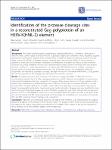Identification of the protease cleavage sites in a reconstituted Gag polyprotein of an HERV-K(HML-2) element
George, Maja
Schwecke, Torsten
Beimforde, Nadine
Hohn, Oliver
Chudak, Claudia
Zimmermann, Anja
Kurth, Reinhard
Naumann, Dieter
Bannert, Norbert
Background: The human genome harbors several largely preserved HERV-K(HML-2) elements. Although this retroviral family comes closest of all known HERVs to producing replication competent virions, mutations acquired during their chromosomal residence have rendered them incapable of expressing infectious particles. This also holds true for the HERV-K113 element that has conserved open reading frames (ORFs) for all its proteins in addition to a functional LTR promoter. Uncertainty concerning the localization and impact of post-insertional mutations has greatly hampered the functional characterization of these ancient retroviruses and their proteins. However, analogous to other betaretroviruses, it is known that HERV-K(HML-2) virions undergo a maturation process during or shortly after release from the host cell. During this process, the subdomains of the Gag polyproteins are released by proteolytic cleavage, although the nature of the mature HERV-K(HML-2) Gag proteins and the exact position of the cleavage sites have until now remained unknown. Results: By aligning the amino acid sequences encoded by the gag-pro-pol ORFs of HERV-K113 with the corresponding segments from 10 other well-preserved human specific elements we identified non-synonymous post-insertional mutations that have occurred in this region of the provirus. Reversion of these mutations and a partial codon optimization facilitated the large-scale production of maturation-competent HERV-K113 virus-like particles (VLPs). The Gag subdomains of purified mature VLPs were separated by reversed-phase high-pressure liquid chromatography and initially characterized using specific antibodies. Cleavage sites were identified by mass spectrometry and N-terminal sequencing and confirmed by mutagenesis. Our results indicate that the gag gene product Pr74Gag of HERV-K(HML-2) is processed to yield p15-MA (matrix), SP1 (spacer peptide of 14 amino acids), p15, p27-CA (capsid), p10-NC (nucleocapsid) and two C-terminally encoded glutamine- and proline-rich peptides, QP1 and QP2, spanning 23 and 19 amino acids, respectively. Conclusions: Expression of reconstituted sequences of original HERV elements is an important tool for studying fundamental aspects of the biology of these ancient viruses. The analysis of HERV-K(HML-2) Gag processing and the nature of the mature Gag proteins presented here will facilitate further studies of the discrete functions of these proteins and of their potential impact on the human host.
No license information

